The Books: A Phenominon In Popular Literary Culture
This page is dedicated to “The Books” themselves. We have made all the “Little Colonel” books available to the public on this site below, including photographs of the covers, title pages, illustrations, etc. To understand the gravity and influence these books had on the public during the early 20th century, we have a faculty publication by Sue Lynn McDaniel in 1991 from Western Kentucky University that discusses this. It makes for very interesting reading, she called Annie Fellows Johnson’s series of books, “…A phenominon in popular literary culture”
Below are some photographs of an almost complete collection of the books that is currently on display at the Pewee Valley Town Hall. You can still find old copies for sale on the Internet.
Links to individual volumes of the Complete Original Little Colonel Books Series are below. Thank you to the University of Pennsylvania Digital Library for the copy of the first release: The Little Colonel (1895)
The other books are on this site, and illustrated. Here they are:
The Giant Scissors (1898)
Two Little Knights of Kentucky (1899)
The Little Colonel’s House Party (1900)
The Little Colonel’s Holidays (1901)
The Little Colonel’s Hero (1902)
The Little Colonel at Boarding-School (1903)
The Little Colonel in Arizona (1904)
The Little Colonel’s Christmas Vacation (1905)
The Little Colonel, Maid of Honor (1906)
The Little Colonel’s Knight Comes Riding (1907)
Mary Ware, The Little Colonel’s Chum (1908)
Mary Ware in Texas (1910)
Mary Ware’s Promised Land (1912)
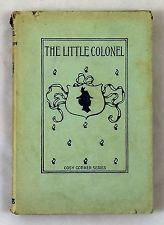 The Little Colonel 1895
The Little Colonel 1895
The beginning of the series. Set in now what is essentially a Louisville suburb, Pewee (Lloydsboro) Valley, a favorite summer retreat of Louisville aristocracy during Victorian times, this is the tale of a bitter old confederate colonel (based on the real-life character of Colonel George Weissinger) and his 5-year old granddaughter (real-life Hattie Cochran) who possessed a certain military demeanor from which she got her name. This is a story of reconciliation and forgiveness. This story is hosted on A Celebration of Women Writers
 The Giant Scissors 1898. This may be Annie Fellows Johnston’s sweetest and most sentimental story. A tear-jerker for those inclined! Written in and set in the little French village of St. Symphorien across the Loire fromTours, it is a tale that reminds one of the thawing heart of old Scrooge in Dickens’ “A Christmas Carol.” When The Giant Scissors was written, it was not with The Little Colonel in mind. However, beginning with The Little Colonel’s House Party, Joyce, The Giant Scissors main character, becomes a major character in the remainder of the series, and frequent references are made to events in this story.
The Giant Scissors 1898. This may be Annie Fellows Johnston’s sweetest and most sentimental story. A tear-jerker for those inclined! Written in and set in the little French village of St. Symphorien across the Loire fromTours, it is a tale that reminds one of the thawing heart of old Scrooge in Dickens’ “A Christmas Carol.” When The Giant Scissors was written, it was not with The Little Colonel in mind. However, beginning with The Little Colonel’s House Party, Joyce, The Giant Scissors main character, becomes a major character in the remainder of the series, and frequent references are made to events in this story.
 Two Little Knights of Kentucky 1899. Old Louisville’s own William and Craig Culbertson are used as the models for little knights Malcolm and Keith in a fictionalized version of a winter and summer visiting their grandmother in Pewee (Lloydsboro) Valley at the close of the 19th century. The relationships are real and even the bear was modeled after a performing bear that came to the valley during that time. This book is a real chance to meet the types of people that lived in and around our city over 100 years ago. Don’t miss the descriptions of a genuine Victorian era Valentine’s Day party and the tableaux which comprised some of the most respected home-made entertainments of the time. “Knighthood has not passed away. The flower of chivalry has blossomed anew in the New World, and America, too, has her ‘Hall of the Shields’”
Two Little Knights of Kentucky 1899. Old Louisville’s own William and Craig Culbertson are used as the models for little knights Malcolm and Keith in a fictionalized version of a winter and summer visiting their grandmother in Pewee (Lloydsboro) Valley at the close of the 19th century. The relationships are real and even the bear was modeled after a performing bear that came to the valley during that time. This book is a real chance to meet the types of people that lived in and around our city over 100 years ago. Don’t miss the descriptions of a genuine Victorian era Valentine’s Day party and the tableaux which comprised some of the most respected home-made entertainments of the time. “Knighthood has not passed away. The flower of chivalry has blossomed anew in the New World, and America, too, has her ‘Hall of the Shields’”
 The Little Colonel’s House Party 1900. Joyce returns from The Giant Scissors along with Malcolm and Keith, from Two Little Knights of Kentucky. They are joined by new characters, among them Betty and Eugenia, who will also become very familiar throughout the rest of the series. A summer-long House Party has been arranged for the Little Colonel. Good times are mixed with the tragic, but lessons learned lead to the “Road of the Loving Heart.” This theme, which continues through the later Little Colonel books, would become an influential model for American girls in the early 20th Century.
The Little Colonel’s House Party 1900. Joyce returns from The Giant Scissors along with Malcolm and Keith, from Two Little Knights of Kentucky. They are joined by new characters, among them Betty and Eugenia, who will also become very familiar throughout the rest of the series. A summer-long House Party has been arranged for the Little Colonel. Good times are mixed with the tragic, but lessons learned lead to the “Road of the Loving Heart.” This theme, which continues through the later Little Colonel books, would become an influential model for American girls in the early 20th Century.
 The Little Colonel’s Holidays 1901 Several chapters of this 1900-1901 tale are set in “Old Louisville.” The Little Colonel and the Two Little Knights of Kentucky have grown a bit, and are joined by the Waltons, modeled after the family of General H. W. Lawton, a fallen hero of the Spanish American War. The story revolves around the search for a little girl who has been “kidnapped” by her drunken father. Yet the real interest may lie in the imagery of Victorian Louisville, good and bad, its values and mores (also good and bad), as well as the descriptions of Victorian holiday celebrations. Well known early in the 20th Century was the Halloween party at the Haunted House of Hartwell Hollow (the house really existed, but burned down by the 1930s). “To ‘The Little Captain’ and his sisters Whose proudest heritage is that they bear the name of a nation’s hero”
The Little Colonel’s Holidays 1901 Several chapters of this 1900-1901 tale are set in “Old Louisville.” The Little Colonel and the Two Little Knights of Kentucky have grown a bit, and are joined by the Waltons, modeled after the family of General H. W. Lawton, a fallen hero of the Spanish American War. The story revolves around the search for a little girl who has been “kidnapped” by her drunken father. Yet the real interest may lie in the imagery of Victorian Louisville, good and bad, its values and mores (also good and bad), as well as the descriptions of Victorian holiday celebrations. Well known early in the 20th Century was the Halloween party at the Haunted House of Hartwell Hollow (the house really existed, but burned down by the 1930s). “To ‘The Little Captain’ and his sisters Whose proudest heritage is that they bear the name of a nation’s hero”
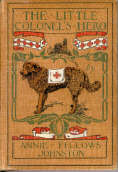 The Little Colonel’s Hero 1902 As the surprise gift for her twelfth birthday, the Little Colonel goes abroad to spend the summer in Europe. In Geneva, she befriends an old Prussian major and his Red Cross dog, a St. Bernard named Hero. The story of the Red Cross is central to the story. Through many adventures on both sides of the ocean, including a return to Tours and the Gate of the Giant Scissors, the Little Colonel, at the end, learns the true meaning of selfless duty. This story is a perennial favorite of Little Colonel fans . “To all the friends of the ‘Little Colonel’ to whose letters the author could not reply, this book is offered in answer to their many questions”
The Little Colonel’s Hero 1902 As the surprise gift for her twelfth birthday, the Little Colonel goes abroad to spend the summer in Europe. In Geneva, she befriends an old Prussian major and his Red Cross dog, a St. Bernard named Hero. The story of the Red Cross is central to the story. Through many adventures on both sides of the ocean, including a return to Tours and the Gate of the Giant Scissors, the Little Colonel, at the end, learns the true meaning of selfless duty. This story is a perennial favorite of Little Colonel fans . “To all the friends of the ‘Little Colonel’ to whose letters the author could not reply, this book is offered in answer to their many questions”
 The Little Colonel at Boarding-School 1903 When the Old Colonel becomes ill, the Little Colonel’s parents must send her to boarding school. Merry times mix with lessons learned that were not in the school curriculum. Little Colonel fans will especially remember the Shadow Club and the story of the Three Weavers. This book was once considered so suggestive that many public libraries, including Pittsburgh and Boston, had it removed from their shelves. How times have changed. “To All the Girls who, like the Little Colonel are “standing with reluctant feet where the brook and river meet, womanhood and childhood sweet.” The Culbertson Mansion collection contains “Mrs. Walton’s” own copy. You can see the dedication page from Annie Fellows Johnston to Mrs. Lawton by clicking here
The Little Colonel at Boarding-School 1903 When the Old Colonel becomes ill, the Little Colonel’s parents must send her to boarding school. Merry times mix with lessons learned that were not in the school curriculum. Little Colonel fans will especially remember the Shadow Club and the story of the Three Weavers. This book was once considered so suggestive that many public libraries, including Pittsburgh and Boston, had it removed from their shelves. How times have changed. “To All the Girls who, like the Little Colonel are “standing with reluctant feet where the brook and river meet, womanhood and childhood sweet.” The Culbertson Mansion collection contains “Mrs. Walton’s” own copy. You can see the dedication page from Annie Fellows Johnston to Mrs. Lawton by clicking here
 The Little Colonel in Arizona 1904 The land around old Camelback mountain near Phoenix is the setting for this story. Joyce and the Ware family have made a new home, and Joyce, especially, is having a difficult time making the adjustment to the “loneliness” of the Arizona desert. That is, until an invalid at Lee’s Ranch tells her the “Legend of Camelback Mountain.” That tale in itself, renamed “In the Desert of Waiting” would later become one of Annie Fellows Johnston’s most popular little books. A letter from Joyce to the Little Colonel brings about her visit to Arizona, and her first real taste of romance in the person of the handsome and personable Phil Tremont. Will he fit the princely mantel suggested by the Three Weavers? Many lessons are given in this book, the most memorable being “the school of the bees” and the legend of Alaka and the lost turquoises. We also meet for the first time in depth the sweet and entertaining Mary Ware, who will play such an important role in many of the future stories.
The Little Colonel in Arizona 1904 The land around old Camelback mountain near Phoenix is the setting for this story. Joyce and the Ware family have made a new home, and Joyce, especially, is having a difficult time making the adjustment to the “loneliness” of the Arizona desert. That is, until an invalid at Lee’s Ranch tells her the “Legend of Camelback Mountain.” That tale in itself, renamed “In the Desert of Waiting” would later become one of Annie Fellows Johnston’s most popular little books. A letter from Joyce to the Little Colonel brings about her visit to Arizona, and her first real taste of romance in the person of the handsome and personable Phil Tremont. Will he fit the princely mantel suggested by the Three Weavers? Many lessons are given in this book, the most memorable being “the school of the bees” and the legend of Alaka and the lost turquoises. We also meet for the first time in depth the sweet and entertaining Mary Ware, who will play such an important role in many of the future stories.
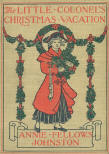 The Little Colonel’s Christmas Vacation 1905 Ten years have passed since we were first introduced to the Little Colonel. The old Lloydsboro Seminary has burned down, and this suits the Little Colonel fine, as she finds herself, along with Betty, Kitty and Allison, at “Dear Old Warwick Hall,” a beautiful mansion run as a boarding school by Madame Chartley on the Potomac, near Washington. In one of the most delightful autumns of her life, the Little Colonel finds new friends, experiences inspiration in her studies and joy in her escapades. Spilled tomato soup begins a course of events on a field trip to Washington that leads to the tale of Ederyn and the importance of “Keeping Tryst.” When a severe case of the flu requires the Little Colonel to extend her Christmas vacation and sit-out the next semester, she learns the meaning of Ederyn’s tale first hand, and in doing so makes her first significant steps into adulthood. For every day selflessly spent , the Little Colonel awards herself a pearl. As the string grows, so does her understanding of life and the world.
The Little Colonel’s Christmas Vacation 1905 Ten years have passed since we were first introduced to the Little Colonel. The old Lloydsboro Seminary has burned down, and this suits the Little Colonel fine, as she finds herself, along with Betty, Kitty and Allison, at “Dear Old Warwick Hall,” a beautiful mansion run as a boarding school by Madame Chartley on the Potomac, near Washington. In one of the most delightful autumns of her life, the Little Colonel finds new friends, experiences inspiration in her studies and joy in her escapades. Spilled tomato soup begins a course of events on a field trip to Washington that leads to the tale of Ederyn and the importance of “Keeping Tryst.” When a severe case of the flu requires the Little Colonel to extend her Christmas vacation and sit-out the next semester, she learns the meaning of Ederyn’s tale first hand, and in doing so makes her first significant steps into adulthood. For every day selflessly spent , the Little Colonel awards herself a pearl. As the string grows, so does her understanding of life and the world.
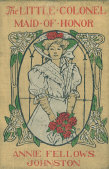 The Little Colonel, Maid of Honor 1906 — It’s time for a second house party! Eugenia is getting married, and the wedding will be at The Locust. Joyce comes with her entertaining sister, Mary Ware, from the Arizona desert to join Betty, The Little Colonel and all the rest of our favorite characters from Lloydsboro Valley in the festive preparations. Charms and dreams, prophesies and warnings, and of course the wedding (actually there are two!) make up this delightful tale. Then there is the matter of the lost turquoises, and whether Lloyd will earn her golden leaf of honor. The stage is set now for the Little Colonel’s own wedding. But we’ll have to wait until the next story to find out for sure who the Little Colonel’s knight will be!
The Little Colonel, Maid of Honor 1906 — It’s time for a second house party! Eugenia is getting married, and the wedding will be at The Locust. Joyce comes with her entertaining sister, Mary Ware, from the Arizona desert to join Betty, The Little Colonel and all the rest of our favorite characters from Lloydsboro Valley in the festive preparations. Charms and dreams, prophesies and warnings, and of course the wedding (actually there are two!) make up this delightful tale. Then there is the matter of the lost turquoises, and whether Lloyd will earn her golden leaf of honor. The stage is set now for the Little Colonel’s own wedding. But we’ll have to wait until the next story to find out for sure who the Little Colonel’s knight will be!
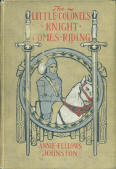 The Little Colonel’s Knight Comes Riding 1907 — When she wrote this, Annie Fellows Johnston intended it to be the conclusion of the Little Colonel series. Of course, as it turned out, that would not be quite true. The stories continued, albeit through a somewhat different perspective, in the Mary Ware series. Only recently the maid of honor, now it will be the Little Colonel’s turn to be the bride, at least that much of it we can give away! But who will it be? A “Knight Comes Riding” in every chapter, but who will finally measure up to the silver yardstick? Will it be one of our old friends, like Little Knight of Kentucky Malcolm MacIntyre, or perhaps Rob Moore, Alex Shelby, Phil Tremont, Jack Ware . . . they are all in the running! Or maybe it will be a new Knight that comes riding! You’ll have to read the story to find out!
The Little Colonel’s Knight Comes Riding 1907 — When she wrote this, Annie Fellows Johnston intended it to be the conclusion of the Little Colonel series. Of course, as it turned out, that would not be quite true. The stories continued, albeit through a somewhat different perspective, in the Mary Ware series. Only recently the maid of honor, now it will be the Little Colonel’s turn to be the bride, at least that much of it we can give away! But who will it be? A “Knight Comes Riding” in every chapter, but who will finally measure up to the silver yardstick? Will it be one of our old friends, like Little Knight of Kentucky Malcolm MacIntyre, or perhaps Rob Moore, Alex Shelby, Phil Tremont, Jack Ware . . . they are all in the running! Or maybe it will be a new Knight that comes riding! You’ll have to read the story to find out!
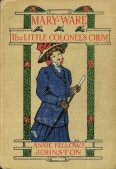 Mary Ware, the Little Colonel’s Chum 1908 Here is the first sequel, or shall we say continuation, of the Little Colonel stories, born of the pressures Annie Fellows Johnston received from her many young readers to continue the series. Although the Little Colonel herself is peripheral to this story, it is a true continuation of the saga. In this tale, we begin with the irascible Mary Ware beginning her first term at Warwick Hall. Mary’s exploits are a delight to read. In many ways, this is the most charming and humorous story of the series — that is until a tragic letter arrives from home. Then Mary, with the “bloodstone (as) her signet, sure token that undaunted courage was the jewel of her soul,” shows that she, too, just as Edryn, can answer “The King’s Call.” This book also contains, as one of its chapters, Annie Fellow’s Johnston’s tale: “The Jester’s Sword.” The Culbertson Mansion collection contains “Mrs. Walton’s” own copy of Little Colonel’s Chum. You can see the dedication page to Mrs. Lawton by clicking here, along with some thoughts.
Mary Ware, the Little Colonel’s Chum 1908 Here is the first sequel, or shall we say continuation, of the Little Colonel stories, born of the pressures Annie Fellows Johnston received from her many young readers to continue the series. Although the Little Colonel herself is peripheral to this story, it is a true continuation of the saga. In this tale, we begin with the irascible Mary Ware beginning her first term at Warwick Hall. Mary’s exploits are a delight to read. In many ways, this is the most charming and humorous story of the series — that is until a tragic letter arrives from home. Then Mary, with the “bloodstone (as) her signet, sure token that undaunted courage was the jewel of her soul,” shows that she, too, just as Edryn, can answer “The King’s Call.” This book also contains, as one of its chapters, Annie Fellow’s Johnston’s tale: “The Jester’s Sword.” The Culbertson Mansion collection contains “Mrs. Walton’s” own copy of Little Colonel’s Chum. You can see the dedication page to Mrs. Lawton by clicking here, along with some thoughts.
 Mary Ware in Texas 1910 Because of Jack’s poor health, the Ware family has moved to Texas. And Mary Ware is beginning to grow up, in more ways than one. The story is set in San Antonio and in Bauer (the fictional name Annie Fellows Johnston gives to the real town of Boerne,) where Annie took her own convalescing son and lived for some years and where she wrote many of the earlier Little Colonel Books. By the time Mary Ware in Texas was published, Annie Fellows Johnston had returned for good to her Promised Land at Pewee Valley, KY. This book then can fairly be considered a collection of the authors reminiscences of Boerne and its people as well as a continuation of the Mary Ware trilogy. This volume contains many lessons for Mary and all girls of that era. Through a series of twists and turns, you will find a much happier story than The Little Colonel’s Chum. And maybe we’ll even see that Mary’s own Knight may have come riding! Maybe.
Mary Ware in Texas 1910 Because of Jack’s poor health, the Ware family has moved to Texas. And Mary Ware is beginning to grow up, in more ways than one. The story is set in San Antonio and in Bauer (the fictional name Annie Fellows Johnston gives to the real town of Boerne,) where Annie took her own convalescing son and lived for some years and where she wrote many of the earlier Little Colonel Books. By the time Mary Ware in Texas was published, Annie Fellows Johnston had returned for good to her Promised Land at Pewee Valley, KY. This book then can fairly be considered a collection of the authors reminiscences of Boerne and its people as well as a continuation of the Mary Ware trilogy. This volume contains many lessons for Mary and all girls of that era. Through a series of twists and turns, you will find a much happier story than The Little Colonel’s Chum. And maybe we’ll even see that Mary’s own Knight may have come riding! Maybe.
 Mary Ware’s Promised Land 1912 — Here we come to the very last of the series of Little Colonel Books. Sort of. This is actually two books in one. Part 1, in 8 chapters, continues where we left off in Texas on the way home to the little mining camp of Lone-Rock in Arizona. Mary plans to stay there only as long as it takes to find a position elsewhere, then finds that there may be just as many reasons to stay. Part 2 gives us Betty’s wedding in Lloydsboro Valley, and finally a life’s mission for Mary Ware: A mission that is for Mary as the King’s call of Edryn. However to “keep the tryst” will force her to make a painful decision between her new-found work and the fulfillment of her life’s dreams. This part of the book is in reality a tribute to, collusion with, and now a history as well of Annie Fellow’s Johnston’s own sister, Albion Fellows Bacon, and her work. Some will recognize “Riverville” as Evansville, Indiana. Albion Fellows work as a reformer, as well as her situation in life, can be found in the character of Mrs. Dudley Blythe. In this book, Annie Fellows Johnston makes her strongest political statements of the series. And here, in Mary Ware, she gives us a heroine whose call goes far beyond that of the Little Colonel, who’s only ambition in life had been to make a Road of the Loving Heart (without breaking any fingernails). For in Mary we find a heroine that hoped to be a “blessing to her generation and a torch that helped to light the way for all who came after her.”
Mary Ware’s Promised Land 1912 — Here we come to the very last of the series of Little Colonel Books. Sort of. This is actually two books in one. Part 1, in 8 chapters, continues where we left off in Texas on the way home to the little mining camp of Lone-Rock in Arizona. Mary plans to stay there only as long as it takes to find a position elsewhere, then finds that there may be just as many reasons to stay. Part 2 gives us Betty’s wedding in Lloydsboro Valley, and finally a life’s mission for Mary Ware: A mission that is for Mary as the King’s call of Edryn. However to “keep the tryst” will force her to make a painful decision between her new-found work and the fulfillment of her life’s dreams. This part of the book is in reality a tribute to, collusion with, and now a history as well of Annie Fellow’s Johnston’s own sister, Albion Fellows Bacon, and her work. Some will recognize “Riverville” as Evansville, Indiana. Albion Fellows work as a reformer, as well as her situation in life, can be found in the character of Mrs. Dudley Blythe. In this book, Annie Fellows Johnston makes her strongest political statements of the series. And here, in Mary Ware, she gives us a heroine whose call goes far beyond that of the Little Colonel, who’s only ambition in life had been to make a Road of the Loving Heart (without breaking any fingernails). For in Mary we find a heroine that hoped to be a “blessing to her generation and a torch that helped to light the way for all who came after her.”
And so we come to the end of the Little Colonel Stories — or do we? Actually, there are just a few more….click here

